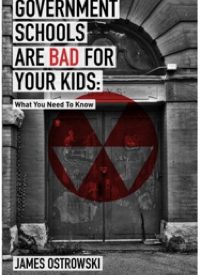
The closure of St. Rose of Lima in Buffalo, New York, ignited a fury in libertarian activist, attorney, and LewRockwell.com contributor James Ostrowski. Ostrowski was furious that his children, who were happily enrolled in the private school, now had to start all over.
“It made me angry that a good school was forced to close because the working class parents who constituted most of its customers could no longer afford to pay twice, first for the government schools they didn’t use and once again for the private school tuition for St. Rose.”
So, what did Ostrowski do in response? He wrote the book, “Government Schools Are Bad for Your Kids: What You Need to Know.” But according to Ostrowski, this isn’t just any ordinary book. His goal is to incite a movement among the various groups who are inspired by the message of liberty. Specifically, Ostrowski is targeting those who rose up to support Congressman Ron Paul’s presidential run and the multitude of people who have come together as part of the more recent so-called Tea Parties. “This book provides the tea party movement with a strategic roadmap to restore the Jeffersonian vision of individual liberty that is the very essence of America…. Direct citizen action is at the heart of the book.” (In the interests of full disclosure, I am friends with the writer of this book, reviewed the manuscript for him before publication, and regularly blog for his political site. I did my best, though, to write this review as an unbiased reader.)
Ostrowski focuses his sights on the government monopoly on education. Government schools weren’t always the mess they are today, but he claims they are too far gone to be saved. “I will admit there was a time when government schools worked better…. Those days are gone. Federal and state bureaucrats and teachers unions, not parents and local school boards, call the shots now. It is time to pull the plug on this failed 150-year-old experiment and move on.”
History
Ostrowski briefly delves into the history of government schooling before he begins diagnosing the problems facing so many today. “Before compulsory, tax-supported government schools became the norm around 1890, American society had survived and thrived without them for over 200 years while creating one of the most successful and literate societies in human history.” Ostrowski explains in painstakingly researched detail how political elites, particularly militant atheists and socialists, enthusiastically endorsed government schooling as part of an “utopian, egalitarian scheme” and not to actually educate the public. If anything, government involvement in schooling was detrimental to American education. He also explains the little-known fact that American religious conservatives contributed to the aggrandizement of state power in education as part of a misguided effort to stifle the spread of Catholic schools. This mistake would come back to haunt social conservatives in spades as the federal government would eventually strictly ban all forms of religious expression from government schools.
Furthermore, Ostrowski argues that government employees are poorly suited to even teach the subject of history. “What does a 99 in a government school American history course mean? That the student has mastered Propaganda 101?” According to Ostrowski, school teachers would never discuss how the Department of Education is unconstitutional because of its role in funding their salaries. On that same point, government employees will generally teach students that more government intervention throughout history has been a positive thing and that only more government involvement will solve almost any problems. Because government schools “control the past, they control the future.” As a matter of fact, Ostrowski argues that this is the reason why so many Americans are historically ignorant. “Being unaware, and thinking that the current regime is the best of all possible worlds, they are utterly unequipped to deal with the new harsh reality that the regime is falling and that the nation is in the process of collapse.”
Fundamental Problems
So what does Ostrowski regard as being the single biggest problem with government schools? “Government schools are coercive institutions; private schools are voluntary…. The rules and regulations governing government schools are rigid, inflexible and by definition, coercive…. The main point is that relations among people in government schools are coercive and involuntary…. It is a top-down, coercive, bureaucratic model of decision-making.” And it is entirely because of the coercive nature of government schooling that government schools are so poor says Ostrowski.
Since government schools have the ability to compel children to attend, they lack the incentive to provide efficient services for their customers. Ostrowski repeatedly argues that government schools are based entirely on government force and ultimately indoctrinate children to be good servants of the politically correct, progressive, secular, wealth-redistributing, warmongering state. “The mere fact that some official has legal authority and the capacity to enforce authority is not sufficient to create moral authority.”
But if that alone doesn’t convince you to reject government schools, Ostrowski highlights many other faults of modern-day government schooling. Ostrowski spends the majority of the book detailing the numerous problems facing government schools such as crime, (“There are daily reports of violent crimes in the government schools, by students and teachers as well, and no doubt many more petty offenses go unreported because bureaucrats like to fudge statistics.”), sex (“many government schools are turning into fornicatoriums featuring more and more sex, and less and less education”), drugs (“schools are the key distribution point for illegal drugs in many communities”), plus the spread of illnesses and widespread use of psychotropic drugs to medicate children into subjugation. His criticisms are not only limited to those areas, as he continues to build a strong case that government schools are far beyond the point of repair.
Direct Citizen Action
Ostrowski’s years of activism have led him to conclude that trying to change the political system from within is a waste of time. In its place, he argues that parents need to resort to direct citizen action. “The essence of direct citizen action is this. Instead of trying to elect new officials, you figure out what you can do right now to accomplish those changes.” Ostrowski’s advice is simple: get them out now! He recommends pulling your kids out of public schools and either enrolling them in private schools or homeschooling them.
In one of the weakest parts of the book, Ostrowski gives some advice that doesn’t seem realistic for many people. In response to the claim that it is too much to pay for private schools in addition to taxes for government schools, he recommends moving to urban areas that have low taxes so you can afford the private school tuition. This advice glaringly overlooks the fact that not everyone appreciates urban living. Certainly there are rural residents who despise living in a city just as there are city dwellers who would prefer to never set foot into suburbia. There is much more to why people live where they do than just the local taxes and schools. Also, the math doesn’t work out if you have multiple children. The tax savings alone will not cover the cost of a private education for a large family. Optimistically looking toward the future, Ostrowski envisions a mass movement toward private schooling that would result in a drastic reduction in costs, but parents with children must make decisions based on what exists today. His soundest advice is recommending home-schooling, which is achievable by mostly everyone and is much more cost-effective. It also doesn’t include the onerous task of relocating your entire family. Homeschooling he argues, is “the best political strategy yet.”
Secondary Benefits
Beyond just weakening the government’s stranglehold on the minds of the nation’s youth, Ostrowski hopes to restore the Republic of old which our Founders struggled so hard to achieve. “America is not what it was supposed to be: a peaceful, libertarian republic with limited, mostly local government…. Instead, we have a huge, intrusive, expensive and distant government that intervenes into every aspect of our lives, taxes us ragged, and has us embroiled in pointless wars and conflicts with strangers in distant lands. The federal government is a monstrosity, always growing in power, size and scope, regardless of how poorly it performs and regardless of how many promises it has failed to fulfill. The government wastes trillions while our own neighborhoods crumble and bank accounts dwindle.” Overall, the book is an impressive effort which aims to strike a devastating blow at the indoctrination centers Ostrowski refers to as government schools. In order to accomplish this, parents must first free their children from the government education system. As we have seen by the homeschooling revolution which has surged in recent years, it appears that many Americans are already taking this path. Hopefully this trend will continue to the point that Ostrowski’s vision becomes a reality.
Government Schools Are Bad for Your Kids: What You Need to Know, by James Ostrowski, Buffalo, New York: Cazenovia Books, 2009, 108 pages, paperback.



